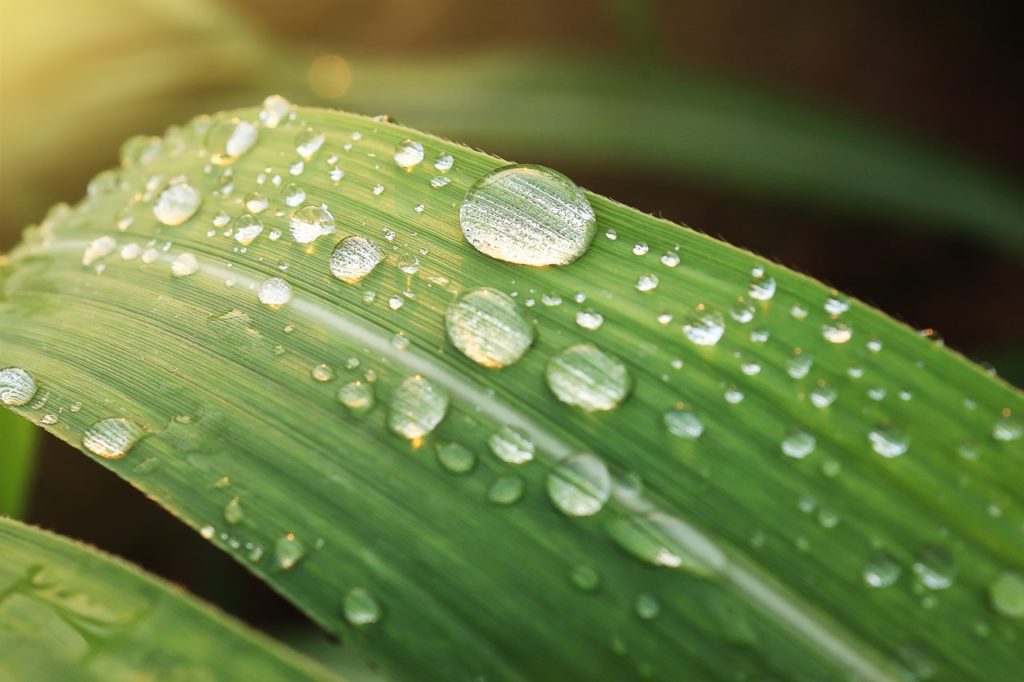
I learned this today. The surface tension of water is higher than almost all other liquids because it contains so much hydrogen.
Surface tension is what allows droplets to form on leaves, like the picture with this post, and for you to keep adding drops of water to a glass without it spilling over the edge. It is the reason a solid steel paperclip will sit on top of a glass of water and not break the surface.
Why does surface tension occur? Every liquid has a surface tension, and it is caused because the molecules of the liquid are attracted to each other more strongly than they are attracted to whatever medium, usually air, is next to them.
Molecules attract each other. They all attract each other with the same amount of force, and they are all attracted by each other with the same amount of force. This means that there is a net zero amount of force. However, the molecules on the top of the liquid are not attracted in every direction. There are neighboring molecules around them and below them, but not above, which means that they are pulled down towards the liquid. This is why water droplets form perfect spheres. All of the droplets on the outside are pulled in towards the center with an equal amount of force.
As an aside: raindrops don’t appear to be spherical because wind resistance changes their shape. Likewise, a droplet hanging from the tap is not completely round because it releases from the tap at different times in different places and gets stretched. If water is released in the ISS, where there is zero gravity, it is completely round.
So, why does water have a higher surface tension than other liquids? It is to do with the amount of hydrogen in it. Water molecules are dipolar. This means they have a positive and a negative charge. The oxygen part of the molecule has a slight negative charge, and the hydrogen ends have a positive charge. Because positives and negatives attract each other, the hydrogen molecules of one water molecule are attracted to the oxygen molecule of another water molecule. This attraction is fairly strong and gives water its very high surface tension. The attraction between the water molecules is far stronger than the attraction between the water and the air.
Surface tension is measured in millinewtons per meter at 20℃. (mN/m). Water has a surface tension of 72.8 mN/m, which is higher than all liquids except one. Chloroform has a surface tension of 26.67 mN/m and ethanol has a surface tension of 22.39 mN/m.
So, what liquid has a higher surface tension than water? Mercury has the highest surface tension of all liquids. The reason mercury has such a high surface tension is because it is basically a liquid metal and the atoms within it form metallic bonds that are far stronger than the hydrogen oxygen bonds of water. The surface tension of mercury is 486.5 mN/m. Almost 7 times stronger than water.
The surface tension of water can be disrupted by simple soap. Detergent molecules have one end that is hydrophilic, which means it loves water, and another end that is hydrophobic, which means that it is repelled by water. Hydrophilic molecules are attracted to hydrogen molecules. Hydrophobic molecules are repelled by the hydrogen molecules. When detergent is added to water, the hydrophilic end of the molecule is attracted to the water, but the hydrophilic end is repelled and pushes up to the surface of the water. It weakens the hydrogen bonds that are holding the water together and breaks the surface tension.
The surface tension of water allows some insects to walk on the surface of a pond. Gerridae (more commonly known as water striders) and corixidae (known as water boatmen) utilize the surface tension of water to be able to run across it without sinking.
Surface tension also allows us to have water resistant materials. A tent that is water resistant will be made of a finely woven material that has very small pores. The surface tension of the water means that when rain falls on the tent the water bridges the pores and stays on the outside of the tent.
Surface tension also allows us to have bubbles. Although we need detergent as well. Water on its own would form a sphere. If detergent is added, the surface tension is lowered, and bubbles can form. The water does still have some surface tension, which is why the bubbles are round.
So, water surface tension is caused because the hydrogen molecules attract the oxygen molecules and they are all pulled towards each other, except for the molecules on the surface. They are only pulled down, giving the surface tension. And this is what I learned today.
Photo by Aphiwat chuangchoem: https://www.pexels.com/photo/water-droplets-on-green-leaf-347925/
Sources:
https://www.biolinscientific.com/blog/surface-tension-of-water-why-is-it-so-high
https://www.mytutor.co.uk/answers/52118/A-Level/Biology/Why-does-water-have-high-surface-tension/
https://www.sciencedirect.com/topics/earth-and-planetary-sciences/surface-tension
https://en.wikipedia.org/wiki/Surface_tension
https://physics.stackexchange.com/questions/2615/are-there-any-liquids-with-zero-surface-tension
https://chemistry.stackexchange.com/questions/1107/why-is-water-a-dipole
https://en.wikipedia.org/wiki/Surface-tension_values
https://en.wikipedia.org/wiki/Mercury_(element)
https://sciencing.com/detergent-break-surface-tension-5452223.html
https://www.usgs.gov/special-topics/water-science-school/science/surface-tension-and-water
